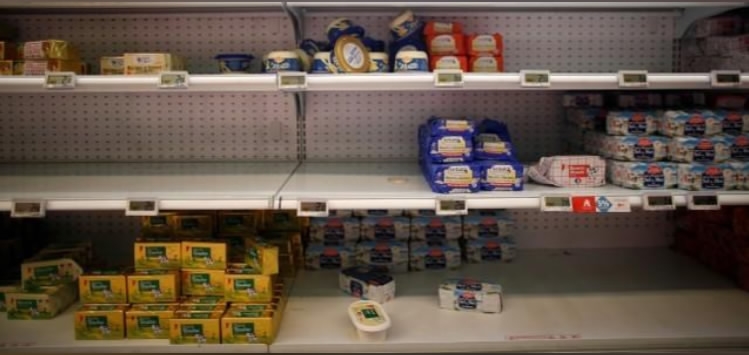France is running short of butter, with some supermarket shelves sitting empty and the price of croissants on the rise, creating a headache for the government just as it tries to make the food chain fairer for farmers.
The shortage is the result of falling milk production and rising butter demand globally, with consumer attitudes toward the spread, once shunned as unhealthy, turning more positive.
As a consequence, France has been caught short. Soaring prices and reduced dairy supplies have put a strain on producers and food businesses, with some halting deliveries and considering passing higher costs onto retailers and shoppers.
Makers of baked goods like croissants, in which butter makes up around a quarter of the content, have been grappling with a doubling of butter prices in the past year to record levels above 6 euros (7.05 US dollars) a kilo.

A customer shops in front of empty shelves in the butter section due to a drop in milk production, at a store in Nice, France, October 23,2017. /Reuters Photo
A customer shops in front of empty shelves in the butter section due to a drop in milk production, at a store in Nice, France, October 23,2017. /Reuters Photo
Speaking in his traditional bakery in Paris, Samir Kichou said he had not yet increased his prices because of extra butter costs but may have to soon.
“Because the year-end holidays are approaching, with Christmas preparations and particularly the ‘Galette des Rois’ cake which needs a lot of butter, if there is not a significant decline, we will be forced to pass on the price rise,” he said.
European dairy processors and food industry groups have been warning of a squeeze, with Danish-based cooperative Arla Foods saying in August that the continent might face shortages by year-end.

Placards notify clients of the butter shortage on shelves in a supermarket in Nice, France, October 23, 2017. The placards read "Dear customers, due to a lack of raw materials, our suppliers are not able to deliver for the moment all our orders of butter" (L) and "butter shortage for unlimited duration, due to a drop in production and a rise in world demand and price conflict with large retailers." /Reuters Photo
Placards notify clients of the butter shortage on shelves in a supermarket in Nice, France, October 23, 2017. The placards read "Dear customers, due to a lack of raw materials, our suppliers are not able to deliver for the moment all our orders of butter" (L) and "butter shortage for unlimited duration, due to a drop in production and a rise in world demand and price conflict with large retailers." /Reuters Photo
Supermarkets in the capital and other parts of France have left gaps in their butter sections, with some stores displaying signs explaining a shortage for certain brands.
Dairy farmers complain that they get little benefit from soaring butter markets, arguing that what they are paid is more often tied to cheaper raw milk and milk powder prices.
“The problem is that on the French market the right signal was not given to dairy farmers, since prices were not adjusted in relation to the drop in dairy supply,” said Dominique Charge, president of France’s federation of dairy cooperatives.

Packages of butter are seen on partially empty shelves in the milk and dairy product section of a supermarket in Saint-Sebastien-sur-Loire, France, October 23, 2017. /Reuters Photo
Packages of butter are seen on partially empty shelves in the milk and dairy product section of a supermarket in Saint-Sebastien-sur-Loire, France, October 23, 2017. /Reuters Photo
The tensions regarding butter supply highlight the challenges faced by President Emmanuel Macron to honor an election pledge to change practices in the food chain so farmers get a better deal.
Agriculture Minister Stephane Travert played down the suggestion of acute shortages, but told Parliament on Tuesday that retailers and suppliers should agree on price adjustments in order to maintain deliveries.
The dairy market has shown signs of correcting, with butter prices easing and milk output expected to pick up in the second half of this year, but the effects of the crunch could linger until the peak holiday demand period at the end of the year.
Source(s): Reuters





